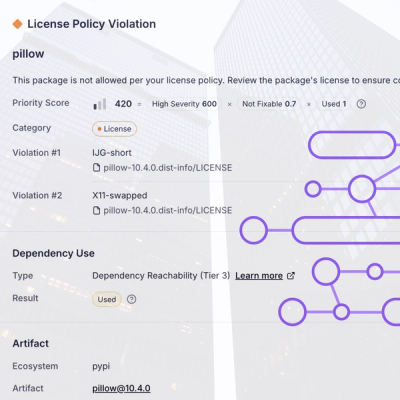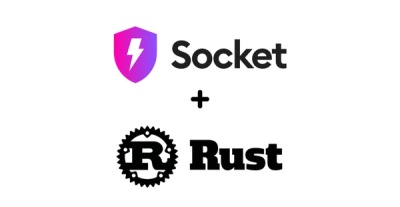
Research
/Security News
Critical Vulnerability in NestJS Devtools: Localhost RCE via Sandbox Escape
A flawed sandbox in @nestjs/devtools-integration lets attackers run code on your machine via CSRF, leading to full Remote Code Execution (RCE).
uproxy-networking
Advanced tools
uProxy's networking library provides a "split SOCKS5 proxy" whose two halves communicate with one another via WebRTC data channels, optionally disguised as some other protocol.
There are two main components: socks-to-rtc and rtc-to-net.
socks-to-rtc provides a local proxy (which the user can point their browser or command-line tools at) which passes requests over a WebRTC peerconnection.rtc-to-net acts as the "remote proxy" which receives the requests from the socks-to-rtc peer over WebRTC, passes the request to the destination webserver, and serves the response back to socks-to-rtc.WebRTC data channels are secured with DTLS.
An observer of the network traffic passing between two connected hosts can see that DTLS is in use; from this, they may infer that data channels are in use. We wish to make it difficult for an observer to detect the use of uProxy.
The SOCKS server can use the churn module to obfuscate its network traffic.
churn configures WebRTC to pass its network traffic through a local network
port which transforms the data prior to sending it over the internet; a
port on the remote host is similarly configured to restoret the data to its
original form prior to delivering it to the remote WebRTC peer.
utransformers is used to transform and restore the data being sent over the network.
npm install -g grunt-clisetup.sh install to get dependencies (from npm, bower, and uproxy-lib tools)grunt compiles all the TypeScript into JavaScript in the build/dev/ directory.grunt test.A variety of sample apps are included.
To run Chrome apps:
chrome://extensions, ensure developer mode is enabled, and load unpacked extension from the relevant directory inside dist/samples/, e.g. dist/samples/simple-socks-chromeapp/.To run Firefox add-ons:
cfx run from the relevant directory inside dist/samples/, e.g. dist/samples/echo-server-firefoxapp/.echo-server-chromeapp starts a TCP echo server on port 9998.
Run telnet 127.0.0.1 9998 and then type some stuff to verify that echo server echoes what you send it.
Press ctrl-D to have the echo server terminate the connection or press ctrl-] then type quit to exit telnet.
simple-socks starts a SOCKS proxy on port 9999. socks-to-rtc and rtc-to-net both run in the same Chrome app, on the same machine, and communicate via direct function calls (no WebRTC datachannels).
To see debugging output, open the background page.
This command may be used to test the proxy:
curl -x socks5h://localhost:9999 www.example.com
(the -h indicates that DNS requests are made through the proxy too, i.e. not resolved locally)
You can also use an extension like SwitchyProxySharp to set Chrome's proxy settings and then just browse stuff.
copypaste-socks-chromeapp/ starts a SOCKS proxy on port 9999. One peer runs socks-to-rtc and the other runs rtc-to-net. The two peers may run on separate machines which may be located on separate private networks. Communication takes place via WebRTC datachannels and the peer-to-peer connection is established by exchanging signalling messages over some medium, e.g. email or, if the peers are on the same machine, copy and paste.
These two samples, simple-churn-chat-chromeapp and
copypaste-churn-chat-chromeapp, demonstrate how the churn module may be
used to drive a two-way chat client.
They are roughly analagous to the simple- and copypaste- SOCKS
Wireshark may be used to verify that the traffic is obfuscated; the endpoints in use - along with a lot of debugging information - may be determined by examining the Javascript console.
Demonstrates the simplest possible use of the turn-frontend and
turn-backend modules.
turn-frontend is the module with which TURN clients directly interact:
+-------------+
| |
| ++ +------->
+-------------+ | ++ |
| | | |
TURN client +-----> | oo | <-------------> | ++ +------->
| oo | webrtc | ++ |
| | | |
+---+---------+ | ++ +------->
turn-frontend | ++ |
| |
+---+---------+
turn-backend
oo ++
oo server socket ++ relay socket
The server may be used with standard TURN clients, e.g. the command-line
tools from the rfc5766-turn-server suite:
apt-get install rfc5766-turn-server on Debian-like systems)turnutils_peer. This starts a UDP echo server on ports 3480 and 3481.turnutils_uclient -s -u test -w test -e 127.0.0.1 127.0.0.1 -p 9997You should see a flurry of activity in the Chrome debugging console. On the
command line, you will soon see a report. The output is not very user-friendly
but the important parts are tot_send_msgs and tot_send_bytes. With the TURN
server, echo server, and TURN client all running locally, you should not see
any dropped packets. For more options, e.g. to open more channels or send
larger datagrams, see the
turnutils_uclient documentation.
android and adb on your PATH (add sdk/tools and sdk/platform-tools to your PATH environment variable)android sdk command.android avd command.
grunt cca will build the project, create an Android APK, and install it onto the device. If no device is attached, the default Android emulator is usedadb forward tcp:19999 tcp:9999 will forward localhost:19999 to the emulator's port 9999.
adb forward tcp:19998 tcp:9998 will forward localhost:19998 to the emulator's port 9998.
telnet localhost 19998 is now the echo server on the deviceFAQs
uProxy's networking library: SOCKS5 over WebRTC
We found that uproxy-networking demonstrated a not healthy version release cadence and project activity because the last version was released a year ago. It has 7 open source maintainers collaborating on the project.
Did you know?

Socket for GitHub automatically highlights issues in each pull request and monitors the health of all your open source dependencies. Discover the contents of your packages and block harmful activity before you install or update your dependencies.

Research
/Security News
A flawed sandbox in @nestjs/devtools-integration lets attackers run code on your machine via CSRF, leading to full Remote Code Execution (RCE).

Product
Customize license detection with Socket’s new license overlays: gain control, reduce noise, and handle edge cases with precision.

Product
Socket now supports Rust and Cargo, offering package search for all users and experimental SBOM generation for enterprise projects.